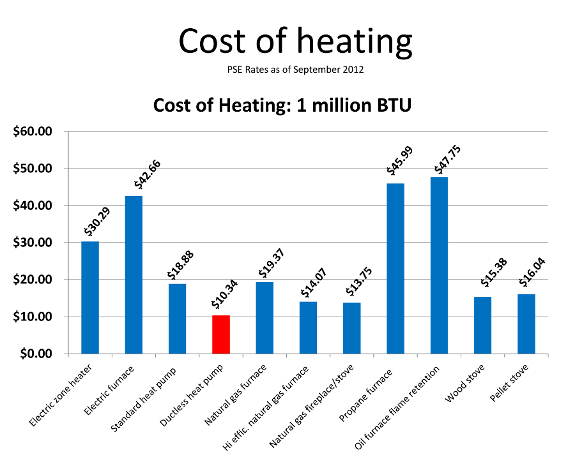
archives for 10/2017
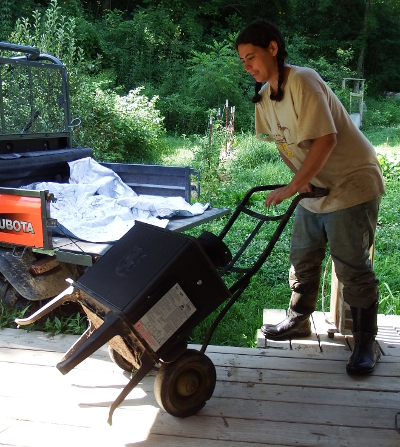 Our
new trailer has no
furnace and we're not sure if we'll get our wood stove installed and
find cured fuel before winter. So now seemed to be the time to get our
act in order about a backup heat source.
Our
new trailer has no
furnace and we're not sure if we'll get our wood stove installed and
find cured fuel before winter. So now seemed to be the time to get our
act in order about a backup heat source.
Mark's first impulse was
geothermal since this is the most efficient heating and cooling option
currently available. Of course, the downside of geothermal is a hefty
price tag. The internet reports that you can install a geothermal
system for as little as $7,000, but my on-the-ground research showed up
$20,000 as the more-likely lower limit. Given the small size of our
space, the current lack of federal tax rebates, and the fact that a
considerable amount of our heat will likely be wood in the long term,
that price tag seemed unrealistic. So I moved on down the list to heat
pumps.
The last time I read
about the heat-pump option, it didn't seem realistic for our region
since heating efficiencies dramatically decline in cold weather. But
since then, science has come to the rescue with variable-speed heat
pumps that don't start losing their efficiency until 5 degrees
Fahrenheit. Plus, if your home is smaller than 1,000 square feet,
ductless heat pumps bring efficiency levels nearly to geothermal status
for a much lower price tag. For example, this
2,400 BTU unit costs
$1,374 (or $947 after Mark's veteran's discount and AEP Ohio's $300
rebate) while boasting operating costs that rival those of a wood stove
if you're buying fuel.
I can just hear Mom
asking, "But what about the noise?" Ductless heat pumps use circulating
refrigerants rather than moving air, so they're much quieter than the
less efficient standard heat pumps. All told, they're currently top of
our list...but I'd love to hear from anyone who's given them a try and
has firsthand information to impart!
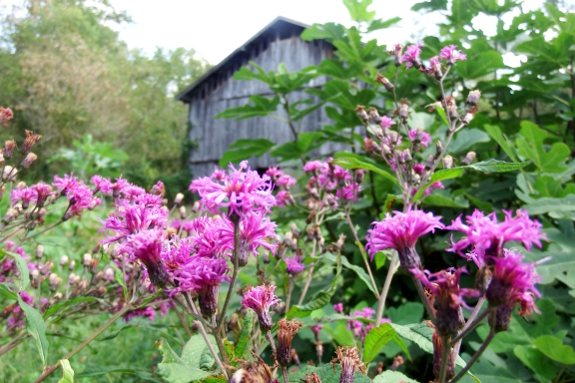
The sumac spice hidden in plain sight was only my latest find around an old homestead. Several years after moving to the country, I followed a faint trail up a hill, and found overgrown blueberry bushes. And then the next year found another blueberry bush I'd missed, and another this year... Now I have a thriving blueberry hill, that produces berries half the summer long.
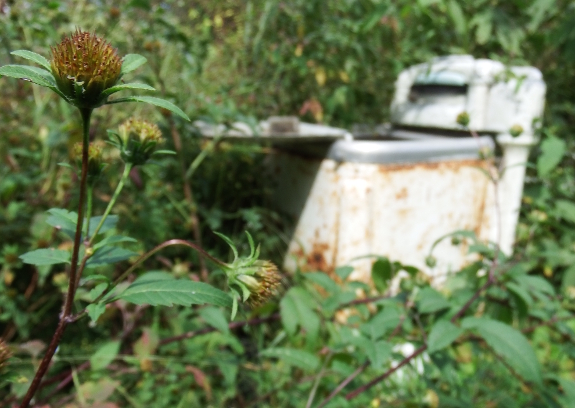
My last time visiting Anna, the encroaching weeds reminded me of when I first visited, soon after Anna bought the place, and well before the beginning of the waldeneffect blog. Then it was a tangle of weeds and brambles, with the bones of an old farm in among them. Walls chinked with newspaper told the tale, of occupants in the 1930's, and a hardscrabble farm.
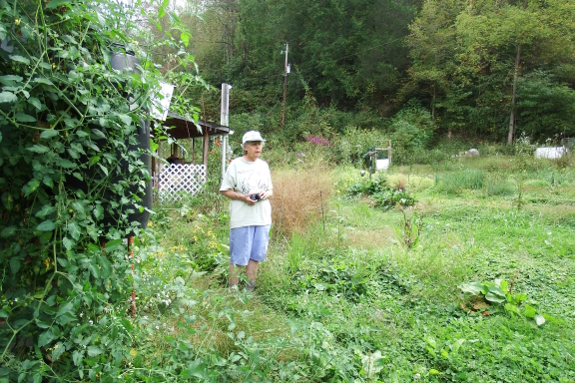
I'm used to software, where each line of code comes with a deep epistolary history of past versions, descriptions, justifications, discussions. A similar history has been built up on this web site, but as weeds choke the place again, perhaps it will be forgotten.
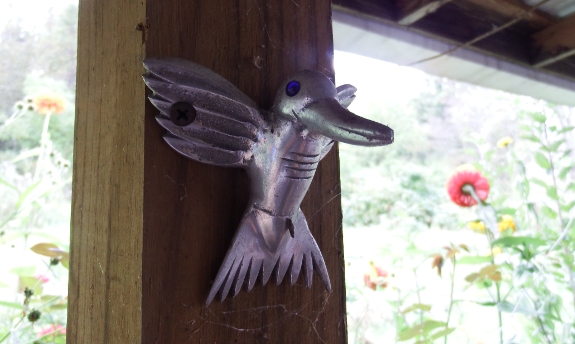
Perhaps a deer hunter one day will notice a row of gnarled fruit trees in the old homestead, or in among a raspberry thicket, find stranger fruits, tiny kiwis and figs. Perhaps a new resident, crossing the ford years from now, will wonder what hands shaped it. Will, as they prune apple and peach, pick spring asparagus, and uncover deposits of unusually rich dirt, find themselves conversing across the years with like minds.
All we know is, we'll remember the place fondly, and look forward to new adventures. Join me in wishing godspeed to Anna and Mark!
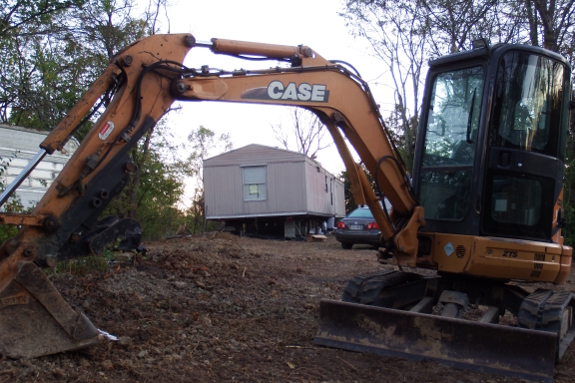
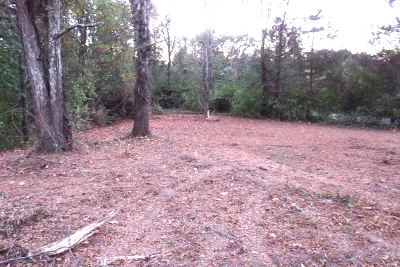 We've
arrived! It was a bit of a shock to show up and find the overgrown
parcel we'd bought cleared and turned into a construction site. But
we'll appreciate the septic system when it's done, and in the meantime
are thoroughly enjoying settling into our new digs.
We've
arrived! It was a bit of a shock to show up and find the overgrown
parcel we'd bought cleared and turned into a construction site. But
we'll appreciate the septic system when it's done, and in the meantime
are thoroughly enjoying settling into our new digs.
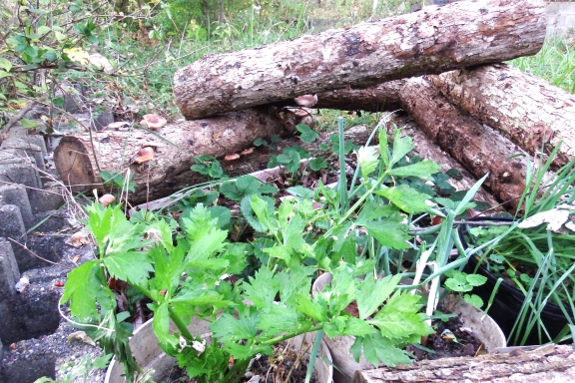
To my surprise, the
herbs and strawberries I left behind during our closing trip are alive
and well. The mushroom logs I used to protect the greenery from deer
produced a flush while we were gone, but otherwise our beginning of a
new garden hasn't missed a beat.
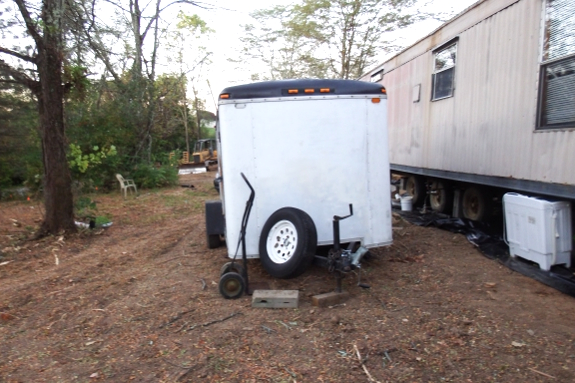
Mostly, though, we're
focusing on zone 0 this week. Scrubbing and mopping, moving in, buying
furniture at the thrift store (they deliver!), and generally getting
used to the area are top of our list. More on the move-in process next
time we stop by the library for our internet fix.
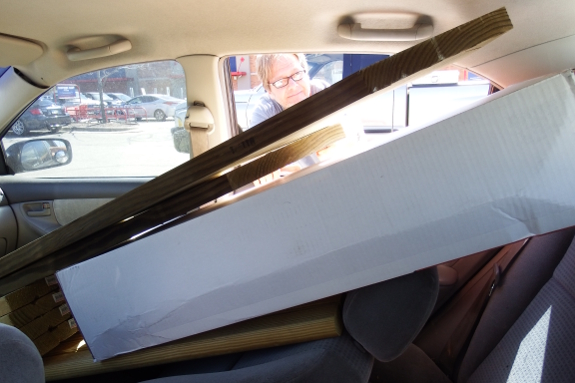
How much lumber can you haul in a Toyota Corolla?
Enough to build a set of stairs and install a mailbox...without making the wife walk home.
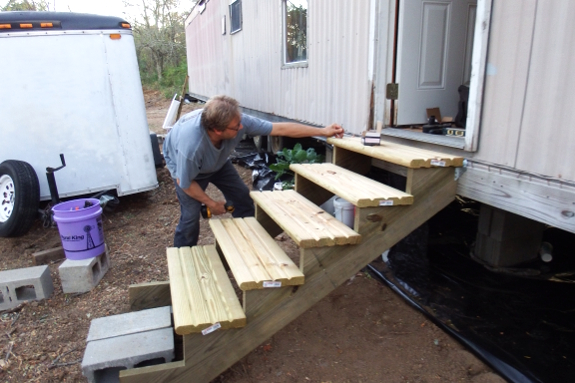
After a day spent
climbing in and out of the trailer using a stack of cinderblocks, we
decided it was time to install some steps. Given our relative lack of
power tools (we only have a couple of charged batteries and no access
to plug-in equipment until our electric is hooked up), we opted for an
inside-the-box solution. Two risers and six precut boards inscribed
with traction channels were pricey but fast and easy to install.
Of course, our
contractor took a look the next morning and informed us we'd done it
all wrong. In Ohio, nothing can be attached to the trailer itself if we
want to pass inspection. Off to buy some
four-by-four posts and support the back end properly!
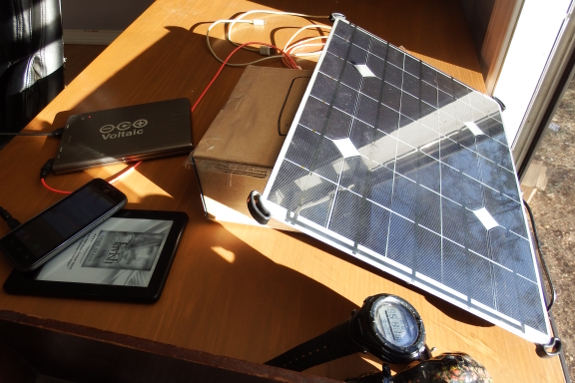
(Thanks, Joey!)
We move it from room to room each day following the sun.
In return, we net enough juice to charge our laptop, cell phone, and ereaders.
Despite having access to the bare digital necessities, we can hardly wait for our electric line, slated to arrive ten days after our final inspection.
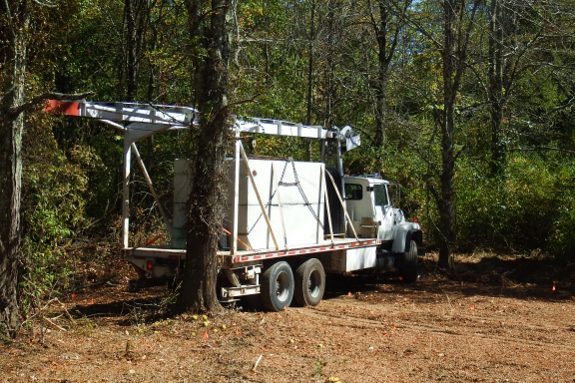
We prioritized steps over
mailbox, so at first it was a bit tough to tell service providers how
to find us. Then I realized I could just tell them to look for
the yard full of construction equipment.
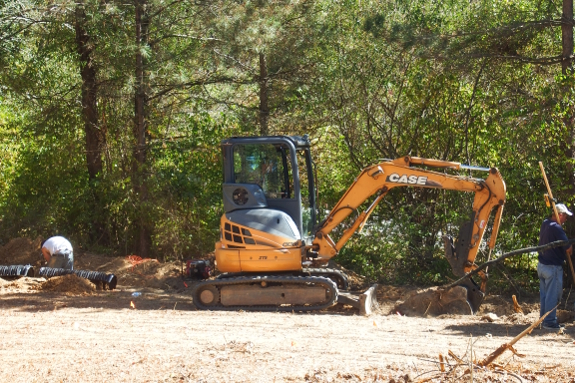
The bulldozer did most
of its work before we arrived, but the trackhoe has been busy on a
daily basis since. Here, it's digging trenches for our septic leach
field.
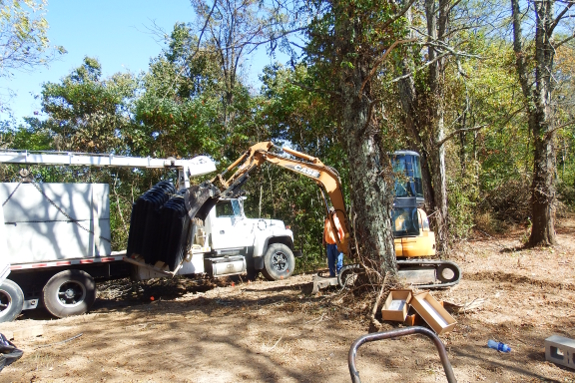
Then on Tuesday, our
herd of equipment grew larger yet as a massive truck came to deliver
our septic tank and tiles. The new beast broke down while hefting the
concrete tank over the trackhoe-dug hole, but a different truck was
back on the job within two hours. It's amazing how much work heavy
machinery can get done in a short amount of time!
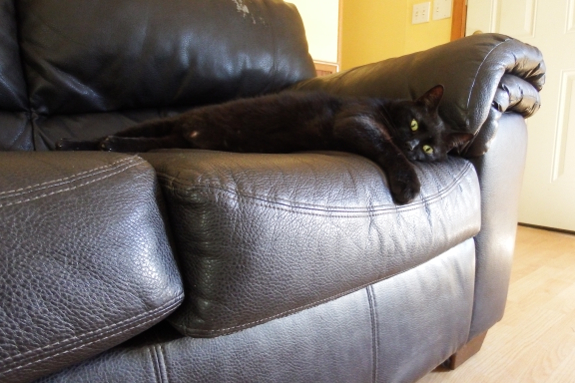
One had a half-off sale.
We landed a lightly distressed pleather couch, a wooden dining table, three kitchen chairs, a desk, a dresser, plus delivery for $172.50.
Cat sold separately.

Our realtor initiated
phase two of his plan this week, lowering
the price of our property to $79,333. He'd initially priced the
farm above market value so the listing would look better when we
dropped it down to our actual asking price.
If you're looking for a
limitless supply of trophy bucks, this is your nudge to take a second
look. We look forward to hearing from you!
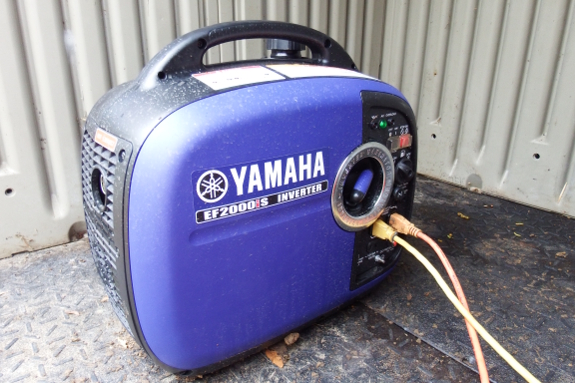
We lasted for one week
with only a
small solar panel
for electricity. Then we fell back on the other option we'd researched
before leaving copious internet access behind --- an inverter generator.
When we bought our
last generator,
inverter generators either didn't exist in our price range or we simply
hadn't heard of them. Since then, though, they've come down into the
consumer price range --- only a couple of hundred bucks for a small,
off-brand model or up to a thousand plus dollars for hefty units that
will likely go the distance.
The
downside is --- you get less power for your buck with an inverter
generator. So why did we decide to go that route anyway?
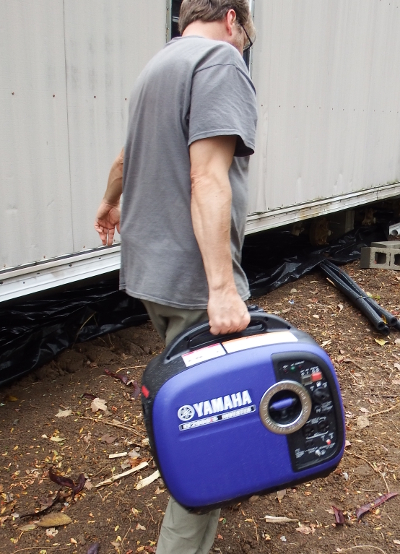 Simple ---
efficiency, fuel savings, and peace and quiet. Basically, inverter
generators are able to run at different speeds depending on how many
things you plug into them. So if you're just running a lamp and
charging a laptop, they'll barely use much fuel at all (about a gallon
for every ten hours of use at 1/4 load) while keeping the noise down to
about the
level of a window air conditioner. Plus, they're small and light enough
to be carried by one strong person alone --- definitely a plus.
Simple ---
efficiency, fuel savings, and peace and quiet. Basically, inverter
generators are able to run at different speeds depending on how many
things you plug into them. So if you're just running a lamp and
charging a laptop, they'll barely use much fuel at all (about a gallon
for every ten hours of use at 1/4 load) while keeping the noise down to
about the
level of a window air conditioner. Plus, they're small and light enough
to be carried by one strong person alone --- definitely a plus.
We'd originally opted
for the 2000 starting watt/1600 running watt Honda, partly because of
its good reviews and partly because it was supposed to be available at
Home Depot (where Mark could use his veteran's discount). But when the
time came to make the purchase, all of the Home Depots in the area had
run out. (You were right, Joey!) So we instead tracked down a Yamaha
with similar stats at a motorcyle store in town --- bonus that we'll
have a repair shop nearby if it needs to be worked on. More on what we
think of our little engine that could in another post.
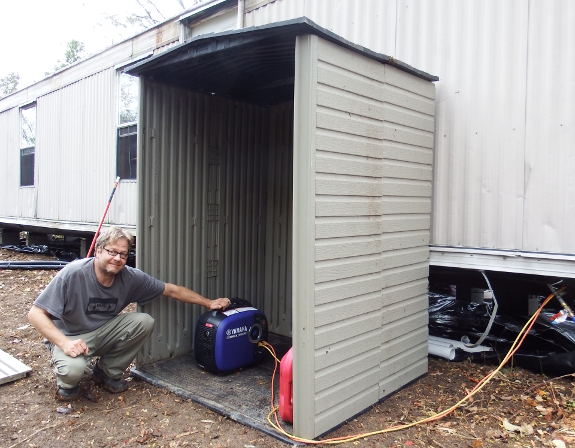
Keep your generator dry.
Point exhaust away from living spaces.

We finally made it to
the Saturday farmer's market. As promised, the array of goodies was
considerably larger than the already impressive Wednesday
offerings.
Mark said I looked only slightly less exuberantly amazed than the
toddler who was running in circles so erratically that she nose dived
into my knee by mistake.
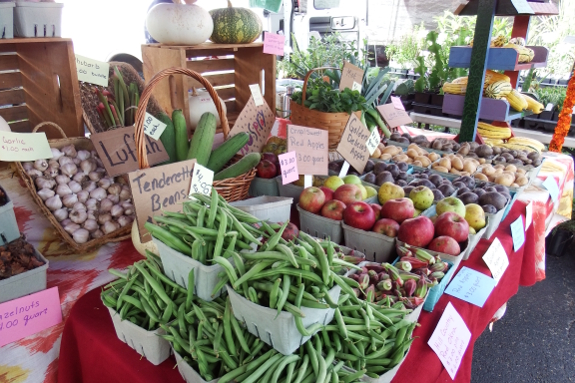
As best I could tell in
my daze of delight, only one stand promised entirely organic produce.
But lots of others were marked "no spray," which I assume is the poor
man's version used by folks who haven't jumped through the hoops to be
officially labeled as organic. I chose copiously from both types of
farmers, falling back on conventional offerings only when I absolutely
couldn't
resist their wares.
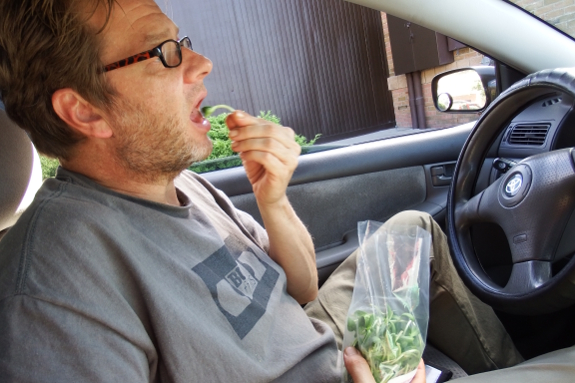
New taste favorites that
we'll likely be trying to grow in the years ahead: sunflower
microgreens, middle eastern summer squash, and another stab at seckel
pears. As the books promised, a ripe seckel pear is indeed a taste
explosion. Mark called the result "magical." High praise from a
husband who's not given to hyperbole!
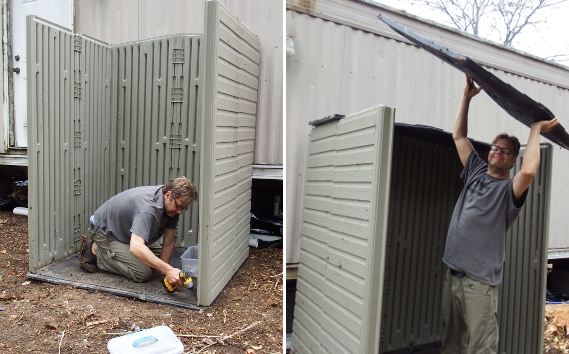
A few screws no longer bit as well as they should have into the plastic. But structural stability was deemed acceptable.
Elapsed time: 20 minutes for two people.
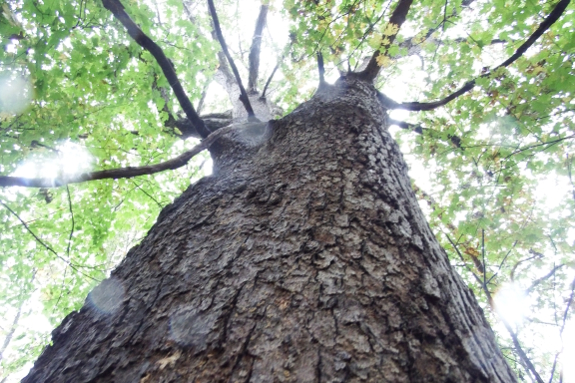
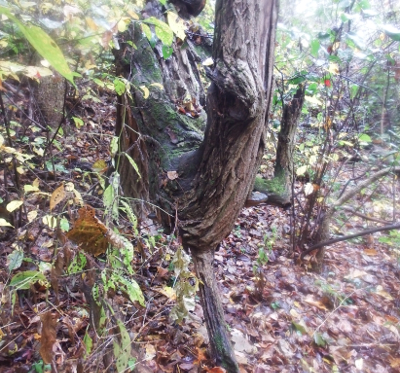 Keeping
up with the basics --- food, water, a spot to use the bathroom, and
staying up to date on our computer work ---
engrossed us for most of the first week. But the ground had been so
parched that when it started raining, I couldn't
resist running out to explore our new domain.
Keeping
up with the basics --- food, water, a spot to use the bathroom, and
staying up to date on our computer work ---
engrossed us for most of the first week. But the ground had been so
parched that when it started raining, I couldn't
resist running out to explore our new domain.
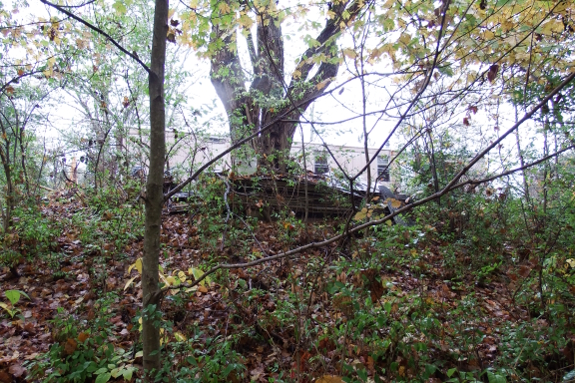
Living so close to the
road has taken some getting used to. But as soon as I slipped down over
the hill, humanity disappeared in very short order.
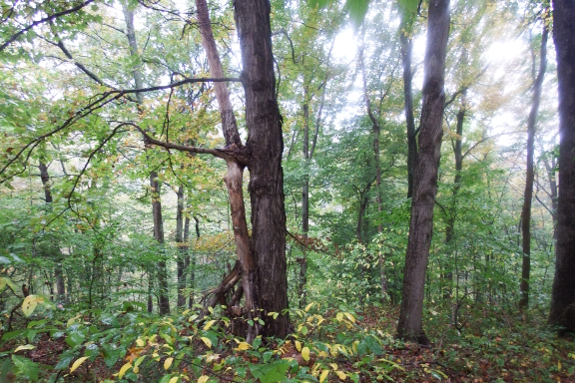
 Various
neighbors have told us that this area was a dairy farm roughly a
century ago.
Sure enough, the trees are mostly the same age once you pass beyond the
easiest-to-reach areas. There are scads of sugar maples, quite a few
beeches, a tulip-tree or two, and even a few oaks. This is in stark
contrast to life on top (our new core homestead) where honey locusts
reign supreme.
Various
neighbors have told us that this area was a dairy farm roughly a
century ago.
Sure enough, the trees are mostly the same age once you pass beyond the
easiest-to-reach areas. There are scads of sugar maples, quite a few
beeches, a tulip-tree or two, and even a few oaks. This is in stark
contrast to life on top (our new core homestead) where honey locusts
reign supreme.
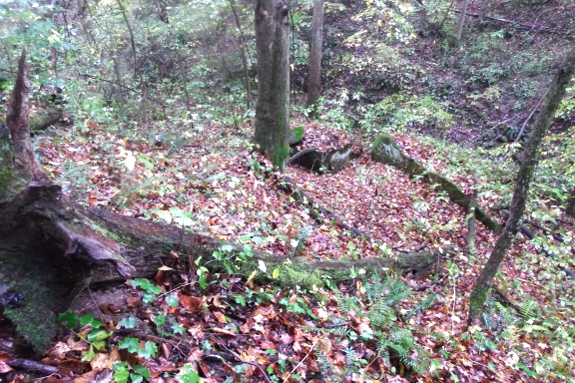
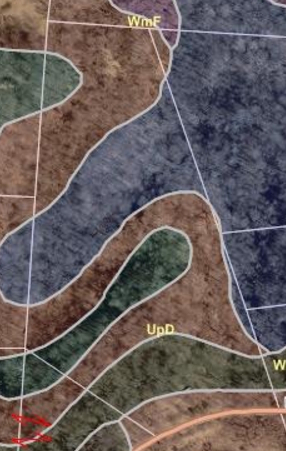 Our
new property consists of a series of plateaus separated by steep banks.
Following the deer trails, it wasn't too hard to get around, although
the walk back up had me huffing and puffing by the end. But I'll
definitely be coming back to my new favorite spot --- an outcropping of
rocks beside a wet-weather creek.
Our
new property consists of a series of plateaus separated by steep banks.
Following the deer trails, it wasn't too hard to get around, although
the walk back up had me huffing and puffing by the end. But I'll
definitely be coming back to my new favorite spot --- an outcropping of
rocks beside a wet-weather creek.
I actually only made it
halfway through the property --- our land goes up the other side past
the creek too. But I want to follow a topo map when I head
further afield. I'll save that expedition for the next time it rains!
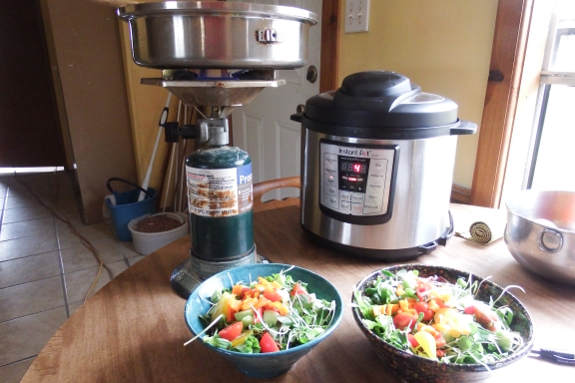
It runs for twelve hours on one tank of gas at a low load --- a few fans, a light or two, and a laptop charger.
The Instant Pot and circular saw work on the generator too, but both run at a slower speed. After the first test, Anna opted to continue cooking on the propane camp stove instead. I kept using my saw.
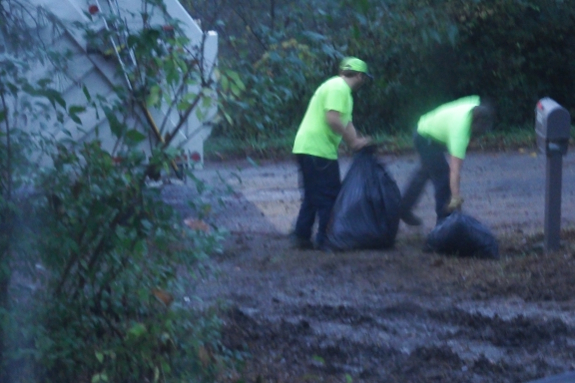
Rural Athens County is a
bit of an odd duck in the garbage department, at least compared to
other areas I've lived in. We're outside the municipal pickup region,
but apparently there are no county-operated dumping stations that
accept private trash. Instead, we have to choose from a slew of
privately run enterprises that pick up garbage at your door.
I figured if we were
going to have to pay for trash disposal, we might as well go all the
way and choose the service that offers recycling. I'm tempted to go
into a long analysis of whether or not the Libertarians are right about
this kind of setup making the most sense...but, honestly, I haven't
entirely decided yet. Perhaps I'll make another post about it in a few
months. Or, given my recent penchant to eschew public politics, perhaps
not.
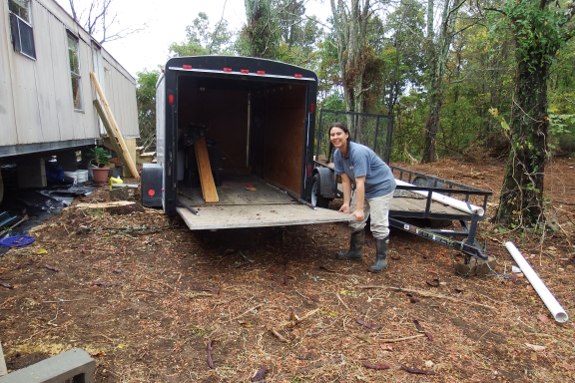
We're still living out of boxes inside, but the new quarters are starting to feel more like home.
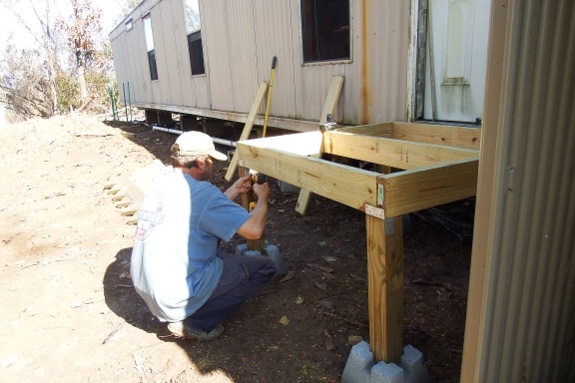
Although plumbing has
consumed a lot of our attention over the last week, we did have time to
make a start on more code-worthy steps.
The beginning is a
landing in front of the door, minimum size three feet by three feet.
We're trying to move this project along so we can get our electricity,
but I took to heart my father's admonition over a decade ago that
building is much cheaper if produced in sizes divisible by eight. So we
expanded out to four feet by four feet instead.
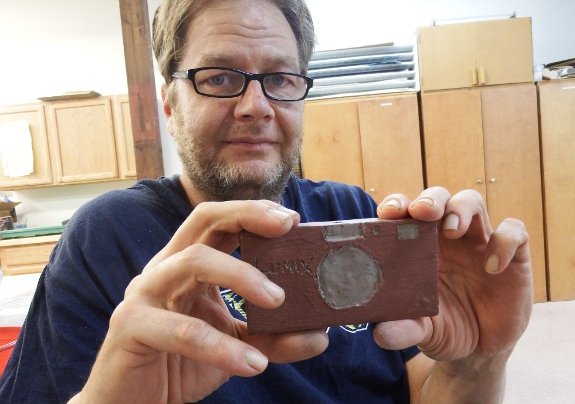
We carved away red clay to make sgraffito blocks to ornament a commemorative trail.
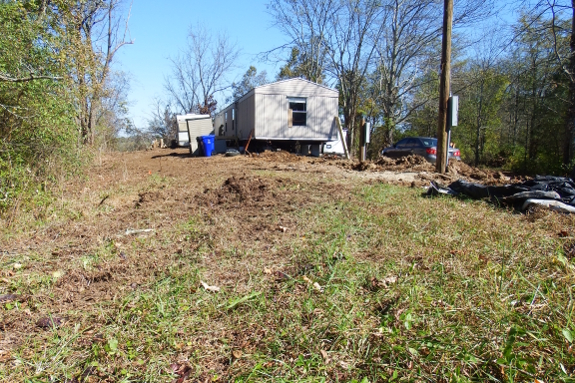
Mom: I need you to share
some photos of your new farm.
Anna: What do you think
I've been posting for the last couple of weeks?
Mom: Those are nice. But
I want long shots.
Anna: Ah! Got it! Here
you go....
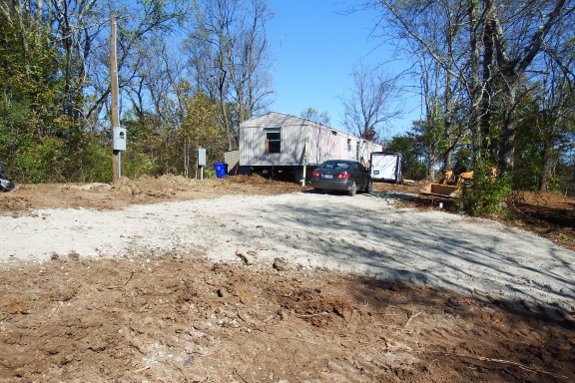
When you turn off the
road, you drive up a short hill to reach our new trailer. This photo is
taken from maybe fifteen feet above the road and showcases the gravel
our construction crew delivered on their last day of work --- crush and
run that would have disappeared into the swamp of our old driveway in
short order but should do well on this much drier site.
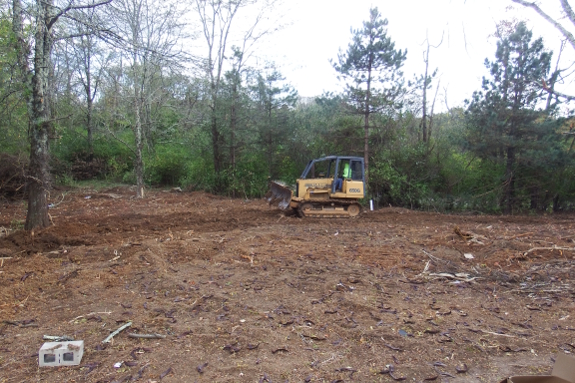
Pretend you parked where
the car is in the previous photo and walked along the front of the
trailer to the door before looking back down toward the road. The area
in front of you is the septic leach field (being graded smooth in the
image above), which will become a grassy lawn with dappled shade from
several honey locusts. A line of Austrian pines and smaller shrubs
separate this area from the road. Our health department contact says
this area shouldn't be garden but can provide grazing for chickens or
low-density goats.
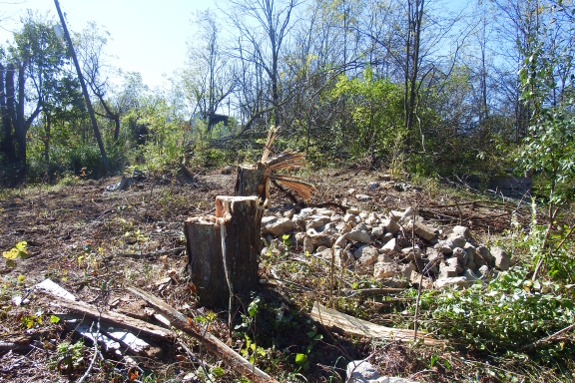
If you walk back to the
car and look southwest away from the trailer, you'll see the recently
deforested zone that will become my garden. (Yes, that electric pole on
the far left has a serious tilt --- they said they'd fix it before they
hook us up.) A big pile of stones looks handy for edging flower beds
around the trailer, and beyond them (not really visible) is the
foundation of an 18-by18-foot building that never quite got built.
Walk uphill a bit then
gaze back toward the trailer and you've returned to the first photo in
this post. Of course, there's a lot more to the property than that, but
most of it is steep hillside, which you toured previously. I hope that helps you get
your bearings and gives you a better idea where we're at!
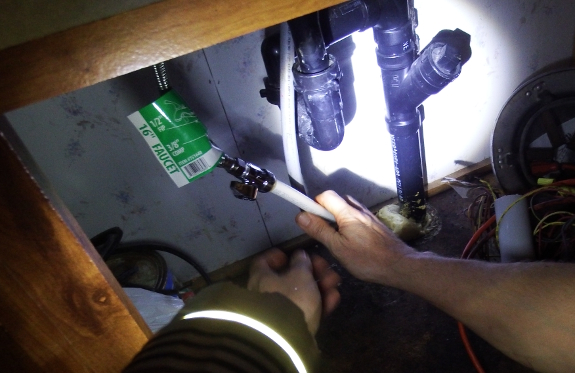
Pex tubing plus shark bite connectors is making replacement a breeze.
The hardest part is tracking down each leak.
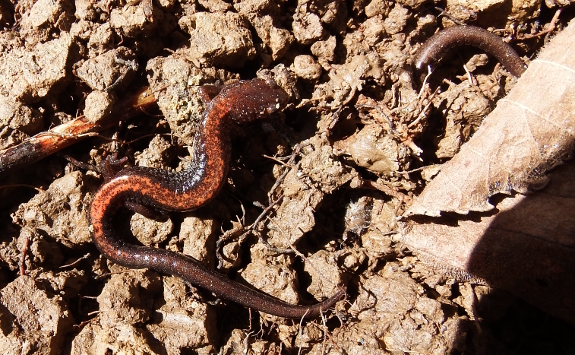
My fingers are itching
for earth...so it's a good thing our construction team is done and I
can finally start claiming spots for garden! This duo of salamanders
showed up under a cinderblock after a rain as I began laying down a
kill mulch to plant a late fall bed.
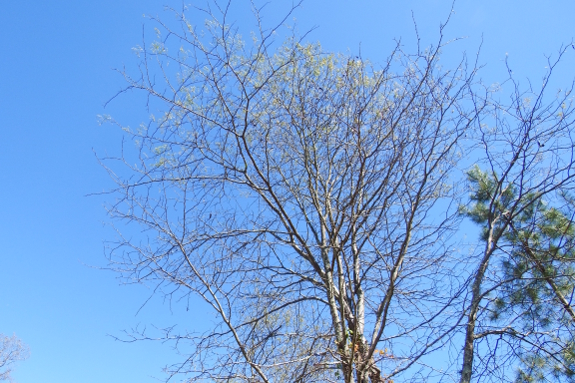
I'm starting up close to
the trailer rather than in my eventual main garden space for the sake
of both simplicity and beauty. The question is --- how much will the
nearby honey locusts shade these garden beds? Can I slip in some
raspberries and strawberries while I'm at it, or will the canopies that
seem very small and open in October block a lot of sun come June?
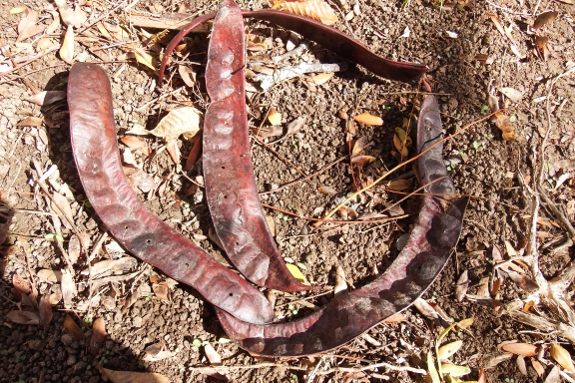
I'd be curioius to hear from
anyone who gardens around honey locusts. I know the
pods are good for animals, but how do plants fare when
planted a few feet away from their trunks?
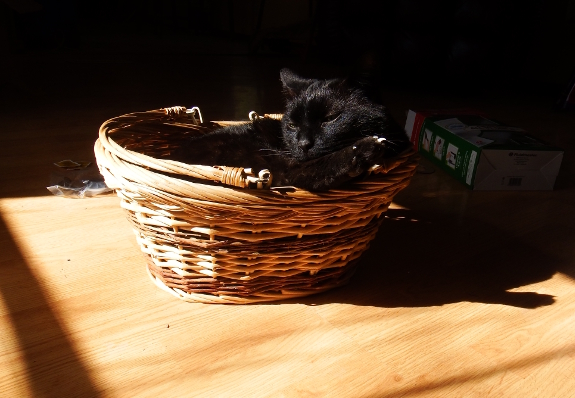
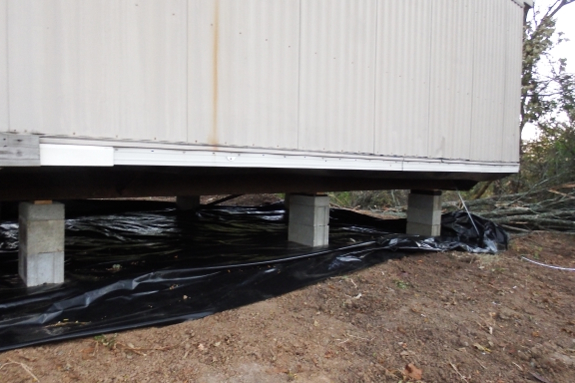
Jennifer:
Sounds
like you two are super busy managing the contractors and doing your own
work. Plus, even just washing and cooking must be a bit of an endeavor
without power and running water. Can you tell us more about a
day-in-the-life in another post sometime?
Anna: Well, we're very
much camping at the moment since we don't have electricity or internet.
So I'm having to run to town three days a week to keep our internet
businesses running while Mark's been busy getting our new place ready
for the inspection. We've been cooking on a camp stove and keeping food
cool in a cooler. Not so bad...as long as the weather stays nice!
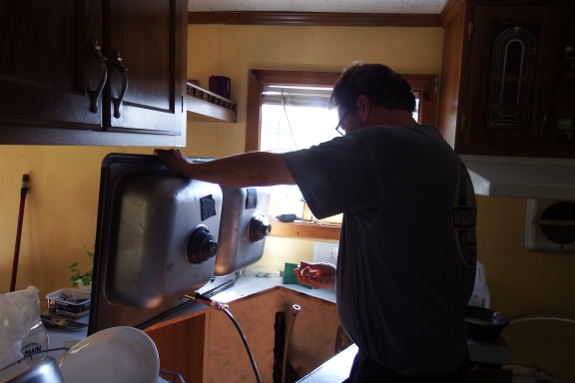
Jennifer: Can you explain
what the "final inspection" is all about?
Anna: Rules are a lot stricter here than they were for folks who live
way back in the woods in Virginia. So we'll have to pass an inspection
that involves not just electric wiring but also basics like foundation,
steps, smoke detectors, and plumbing before we'll be okayed to have our
power turned on. After that, there's a final inspection that checks on
skirting before we get the state's official seal of approval. It turns
out the septic system that I thought was the big important hoop isn't
so essential here --- maybe we could have gotten away with a composting
toilet after all?
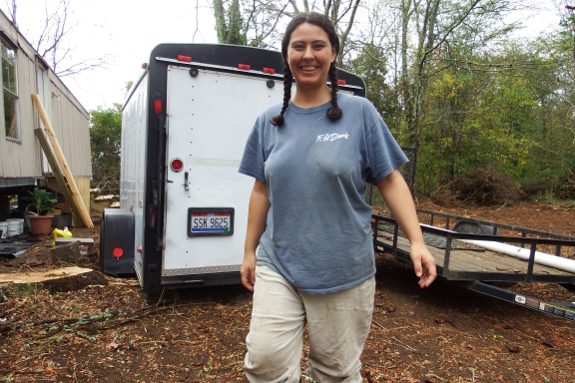
Jennifer:
What is similar and what is
different from how you lived before? What do you like better already
and what do you miss?
Anna: At the moment, I miss having on-demand internet. You don't
really realize how much business you slide into random breaks during
the day until you have to squeeze it all into a few hours per week at
the library. I suspect that, in the long run, what I'll miss most is
our beautiful creek and ability to stretch out in all directions
without worrying about bothering or being bothered by anyone. Plus, my
rich garden soil will take years to replicate.
On the like-better front --- I don't miss our swamp at all. I really
enjoy not having to drive for an hour to hit most stores, and the
amazing farmer's market and intellectual opportunities in town are
invigorating. There's a really nice free newspaper, the potential for
door-to-door compost delivery, and much better solar gain for the
garden. Overall, I'm
pretty sure we made a good choice to pull up stakes and move north.
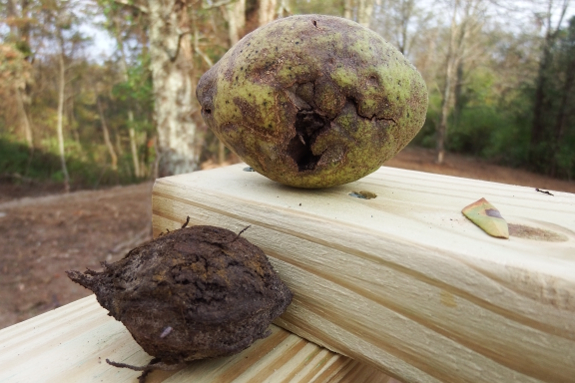
Jennifer: Is the chaos making you
crazy?
Anna: Yes.
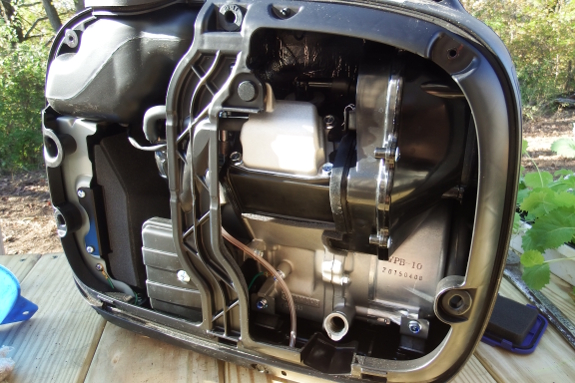
We already can't imagine how we'd live without her.
She comes inside at night and when we leave home, so hopefully we'll never have to find out.
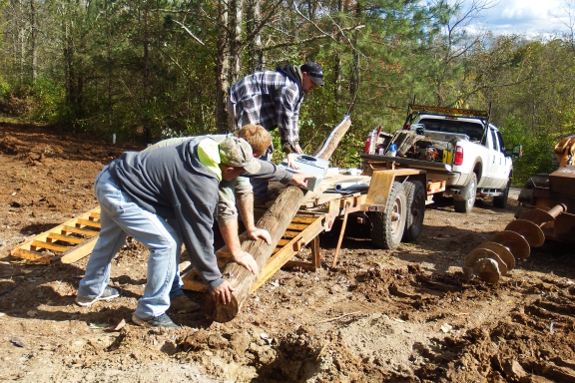
Our crew's last job was
installing an electric pole for the power
company to connect to. The guys were clever and did all the wiring in
the shop then brought the whole shebang to our place to slide into a
auger-dug hole.
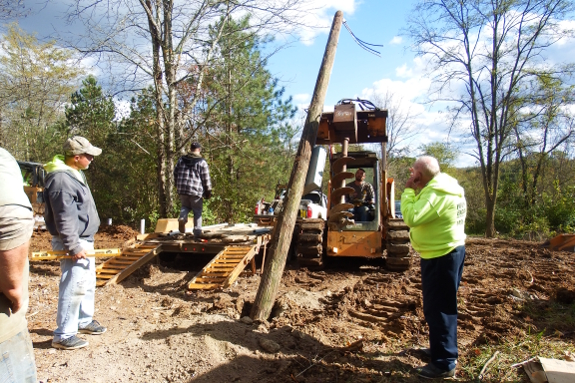
Up she goes!
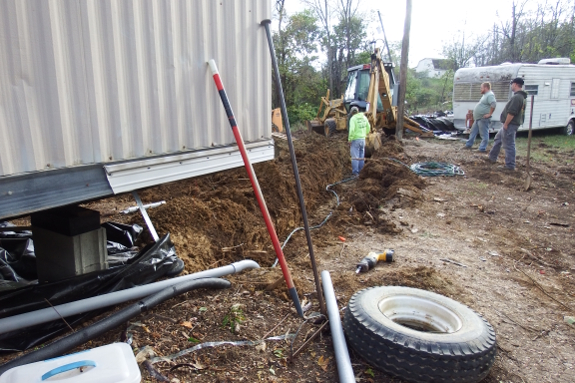
The wire is protected by
conduit as it goes into and out of the ground
but is bare for the rest of its length. It's also right next door to
the easily-puncturable water line. Think I can remember that spot and
not try to plant a tree there?

After the pole was up
and the hole filled in, we had to say farewell to
Lacey and her human family. We enjoyed having the pup oversee our
project, but at a rate of $13,270 for labor and supplies to clear
brush, cut down several trees, install our septic system (the biggie at
$8,500), move and set
up our trailer, hook up the water and electric lines, and gravel our
driveway, we couldn't afford to keep her around much longer. Good thing
Huckleberry
doesn't charge those kinds of rates!
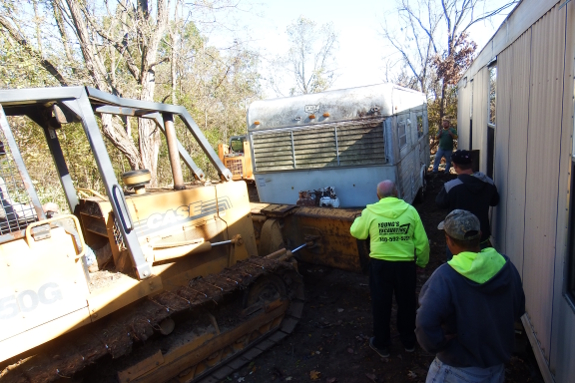
Our land came with a 1969 Holiday camper.
Both realtor and sellers thought it was a liability rather than an asset. But we plan to use the camper for storage while we're getting up to speed.
We did ask the crew to tuck her away around the back out of sight, though, in case neighbors consider the ancient pull-behind an eyesore.
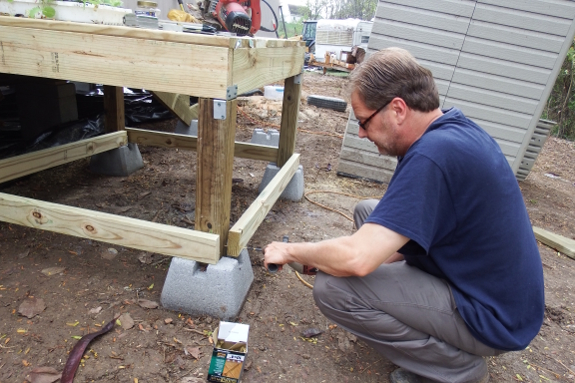
We like the shortcut of
using pier blocks at the base of four-by-four posts, but the resulting
structure can sometimes be a bit wiggly. On our new stair landings,
we added braces at the bottom to shore up the mini-porch.
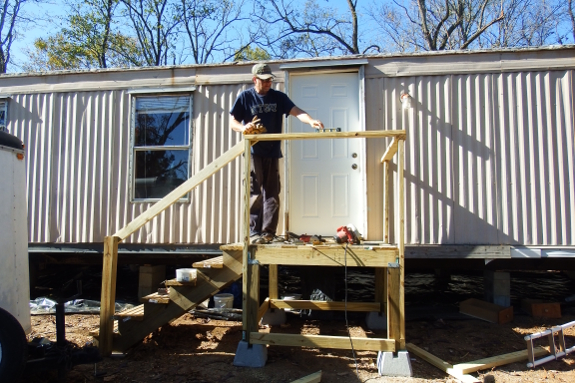
Next up was handrails,
mandatory for stair landings more than 30 inches off the ground in our
region. Depending on who we talked to, the handrails needed to be 34 to
38 inches or 36 to 40 inches above the porch level, and might need an
upright every four feet. We added two additional supports after taking
the photo above just in case.
Now we just have to fix
a GFCI, wrap the water intake to our trailer in heat tape, and install
smoke detectors and we'll hopefully pass our upcoming inspection. I can
hardly wait to mark the last item off our "have to" list and move on
to the "want to" list!
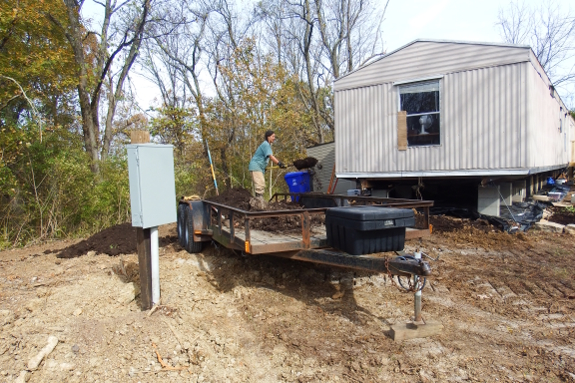
What's the going rate for store-bought compost in Athens, Ohio?
One business charges $45 per cubic yard plus $50 for delivery.
Our neighbors brought us about one and a half cubic yards of aged cow manure mixed with topsoil for 30 bucks.
Want more in-depth information? Browse through our books.
Or explore more posts by date or by subject.
About us: Anna Hess and Mark Hamilton spent over a decade living self-sufficiently in the mountains of Virginia before moving north to start over from scratch in the foothills of Ohio. They've experimented with permaculture, no-till gardening, trailersteading, home-based microbusinesses and much more, writing about their adventures in both blogs and books.
